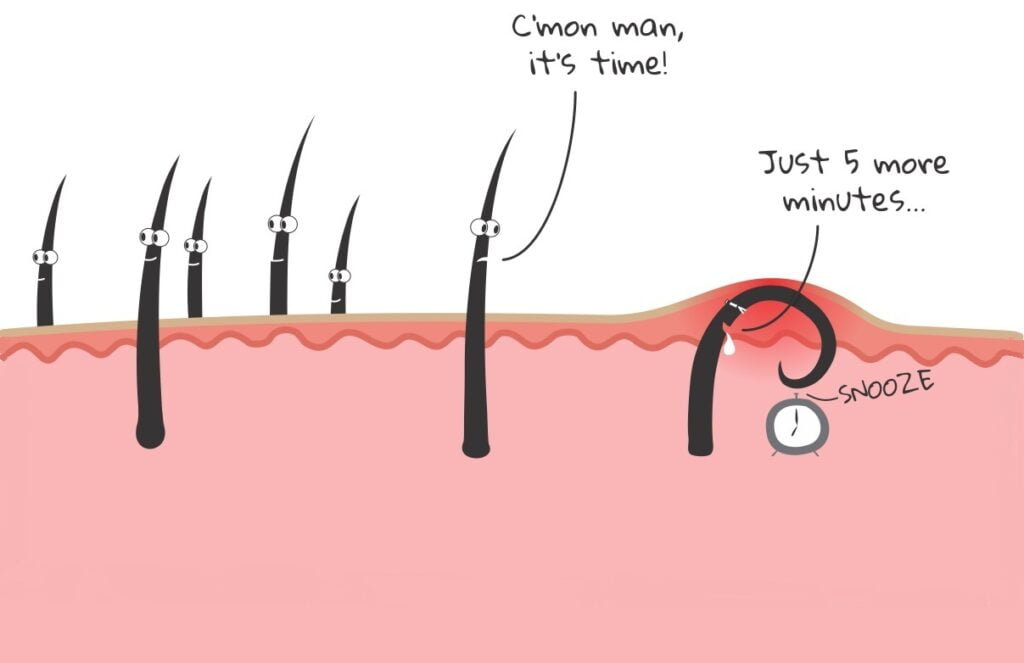The ingrown hair cyst refers to an ingrown hair that turns into a cyst. It is a large bump that extends between the skin’s surface and deep underneath it. The appearance of it is a cross between regular ingrown hair and an acne cyst, but they are different conditions. These types of cysts are very common among people who wax, shave or use other methods to remove their hair.
You may want to rid of this cyst due to its appearance, but it is very important to pay attention to any signs of infection. The ingrown hair cyst starts off as ingrown hair. At first, you can notice a small pimple-like bump that has hair at its surface. Also, it might be red in color.

As time passes, if the ingrown hair does not go away, then the small bump can transform into a much larger one. The resulting cyst can be yellow, white, or red in color. Also, it can be painful to the touch. The ingrown hair cyst can happen anywhere on your body, but it is most likely to happen in areas that are prone to ingrown hairs. These areas include:
- Pubic region
- Legs
- Neck
- Head
- Face
- Armpits
The ingrown hair cyst is not the same thing as cystic acne, but these two conditions can look similar. The infected ingrown hair cyst starts off as regular ingrown hair, and the acne cyst is caused by a combination of oil and dead skin cells which accumulate deep under the hair follicle. Cystic acne can be widespread in one area, such as the face or back.
The ingrown hair cysts are smaller in number and contained. For example, you may have just one. The ingrown hair cyst will not have a head like the pimples. The primary goal of the treatment is to reduce the surrounding inflammation and to decrease the risk for infection.
You should never pop the ingrown hair cysts because in this way you can increase the risk for infection and scarring. Also, you should not try to lift the hair out with tweezers like you might with normal ingrown hair. At this point, the hair is embedded too deep underneath the cyst for you to pull out.
It is very important to talk with your doctor which will be the best way for dealing with the ingrown hair cysts. If you have some infection caused by the ingrown hair cyst, then your doctor can recommend you some oral or topical antibiotics. This can help to reduce inflammation and pain and at the same time, it will prevent the infection from spreading and getting worse.
Ingrown Hair Cyst: Causes
Contents
One of the main causes of ingrown hair cysts is improper hair removal [1]. Whether you wax, shave or tweeze, removing hair is not always clear–cut. This process itself can cause swelling and this can irritate your skin and can lead to pimples and resulting cysts. Also, removing hair can cause the new hair that grows in its place to grow incorrectly.
The new hair can grow sideways and it can eventually curl back down. When this happens, then the pore can close over the hair, so it becomes ingrown or stuck. The skin is responding by becoming inflamed, which is treating the curled–back hair as a foreign object.
It is noticed that most commonly ingrown hairs alone happen in African – American men who shave [2]. If you have naturally curly hair, then you have an increased risk for developing the ingrown hair cyst.
Ingrown Hair Cyst: Risk factors
Every single person can develop ingrown hair, which could lead to ingrown hair cyst, but some factors can increase the risk of it, such as
Having coarse, curly, or thick hair
This type of hair has more chances to curl back under the skin when it exits the hair follicle. [3]
Pressure or friction
This can be a problem, especially in an area that is already vulnerable to ingrown hairs. It can make the ingrown hairs more likely by irritating the skin.
Very dry skin
The dry and dead skin can accumulate over a hair follicle, which is trapping the growing hair underneath. [4]
Hair removal techniques
Plucking, waxing, and shaving can irritate the skin. After shaving, the hair which grows back can have a sharper edge and this makes it easier for it to grow into the skin. [4,5]
References:
[1] Luo DQ, Liang YH, Li XQ, et al. Ingrowing hair: A case report. Medicine (Baltimore). 2016;95(19):e3660. doi:10.1097/MD.0000000000003660
[2] American Osteopathic College of Dermatology. Pseudofolliculitis barbae. Retrieved from www.aocd.org/page/pseudofolliculitisb
[3] NYU Langone Medical Center. Best practices for ingrown hair or ‘razor bumps’. Science Daily. 2015. Retrieved from www.sciencedaily.com/releases/2015/01/150128170057.htm
[4] Qiu W, Gu PR, Chuong CM, Lei M. Skin cyst: A pathological dead-end with a new twist of morphogenetic potentials in organoid cultures. Frontiers in Cell and Developmental Biology. 2021.
[5] NHS. Ingrown hairs. Retrieved from www.nhs.uk/conditions/ingrown-hairs
[6] https://www.ncbi.nlm.nih.gov/pmc/articles/PMC6585396/




